Critical Analysis: Law, Equal Opportunity, and Gender in Australia
VerifiedAdded on 2021/06/18
|5
|1266
|42
Essay
AI Summary
This essay critically examines whether the law provides equal opportunity, with a specific focus on gender, within the Australian context. It begins by defining equality and exploring how societal factors, such as gender stereotypes and unequal power dynamics, influence the application of law. The author argues that the law often fails to provide equal opportunities due to these societal biases, particularly in the context of female stereotypes. The essay discusses the perspectives of feminists and scholars on formal versus substantive equality, highlighting how laws may treat men and women differently, and how the law has historically excluded women from equal participation. It analyzes specific examples, such as the Sex Discrimination Act, employment inequalities, and the limitations of legal binaries. The essay further explores the impact of societal structures and media representations on women's access to justice and concludes by emphasizing the need for revised laws, informed by feminist perspectives, to achieve genuine equality and address unequal distribution of power. The essay references the Australian Human Rights Commission and other relevant sources.
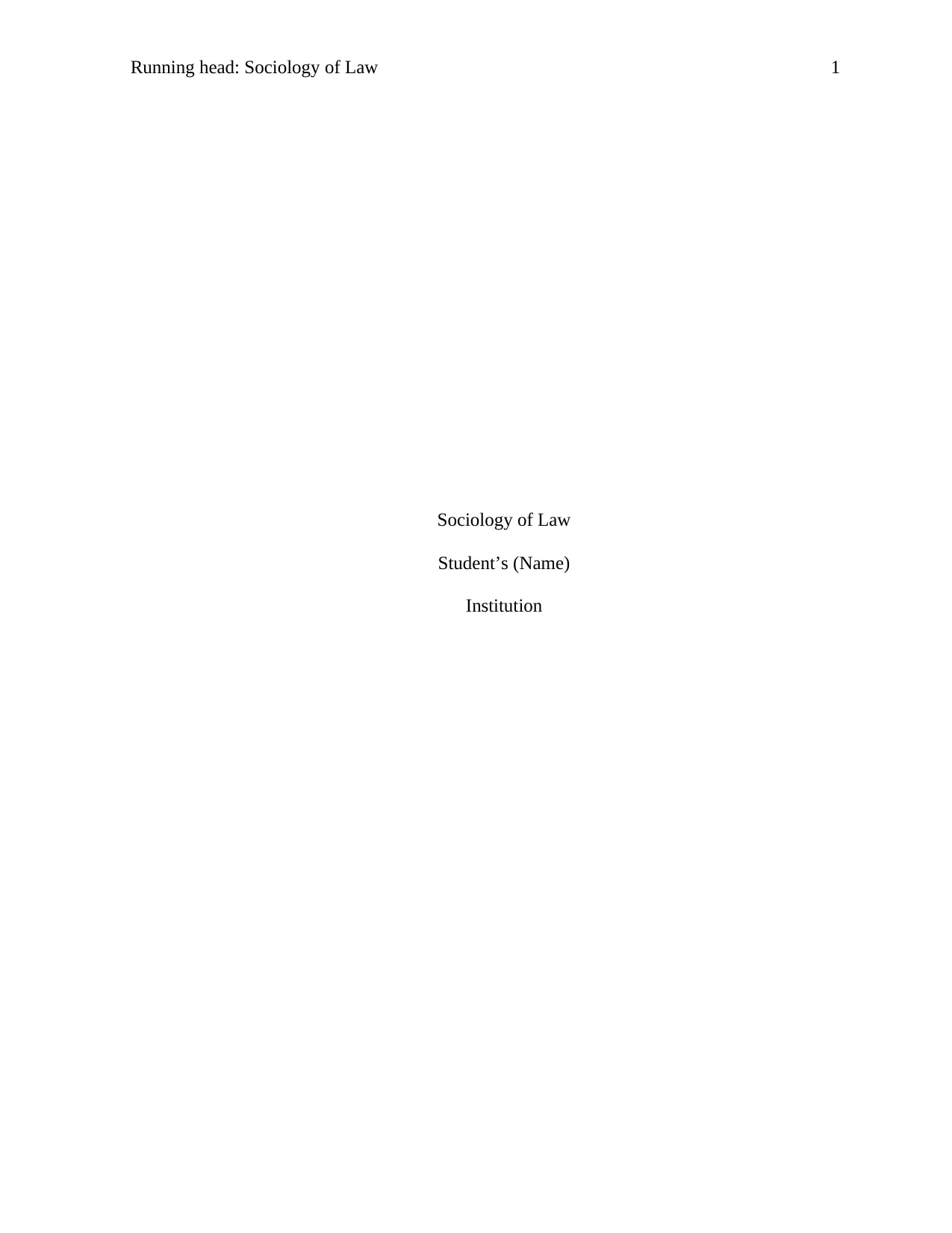
Running head: Sociology of Law 1
Sociology of Law
Student’s (Name)
Institution
Sociology of Law
Student’s (Name)
Institution
Paraphrase This Document
Need a fresh take? Get an instant paraphrase of this document with our AI Paraphraser
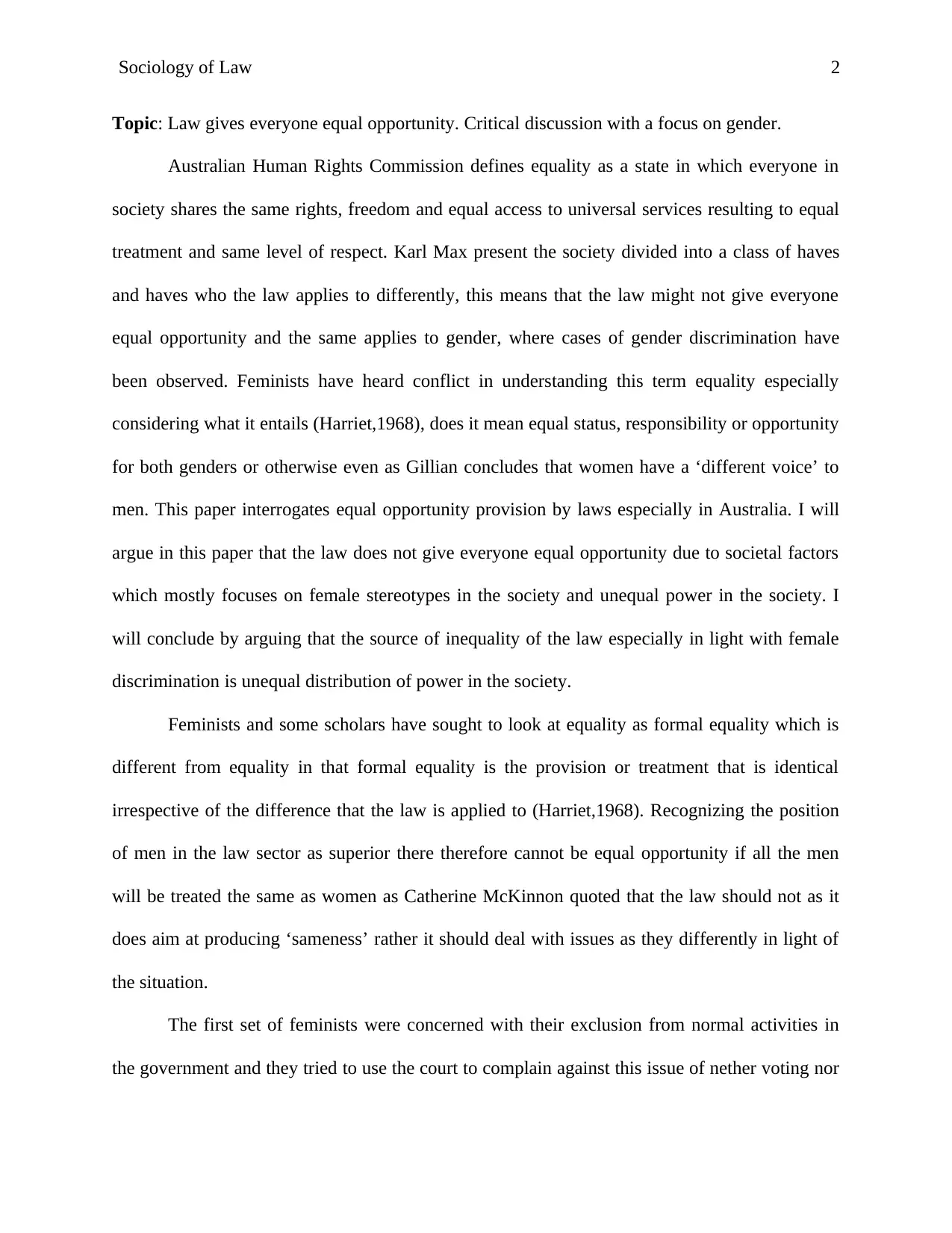
Sociology of Law 2
Topic: Law gives everyone equal opportunity. Critical discussion with a focus on gender.
Australian Human Rights Commission defines equality as a state in which everyone in
society shares the same rights, freedom and equal access to universal services resulting to equal
treatment and same level of respect. Karl Max present the society divided into a class of haves
and haves who the law applies to differently, this means that the law might not give everyone
equal opportunity and the same applies to gender, where cases of gender discrimination have
been observed. Feminists have heard conflict in understanding this term equality especially
considering what it entails (Harriet,1968), does it mean equal status, responsibility or opportunity
for both genders or otherwise even as Gillian concludes that women have a ‘different voice’ to
men. This paper interrogates equal opportunity provision by laws especially in Australia. I will
argue in this paper that the law does not give everyone equal opportunity due to societal factors
which mostly focuses on female stereotypes in the society and unequal power in the society. I
will conclude by arguing that the source of inequality of the law especially in light with female
discrimination is unequal distribution of power in the society.
Feminists and some scholars have sought to look at equality as formal equality which is
different from equality in that formal equality is the provision or treatment that is identical
irrespective of the difference that the law is applied to (Harriet,1968). Recognizing the position
of men in the law sector as superior there therefore cannot be equal opportunity if all the men
will be treated the same as women as Catherine McKinnon quoted that the law should not as it
does aim at producing ‘sameness’ rather it should deal with issues as they differently in light of
the situation.
The first set of feminists were concerned with their exclusion from normal activities in
the government and they tried to use the court to complain against this issue of nether voting nor
Topic: Law gives everyone equal opportunity. Critical discussion with a focus on gender.
Australian Human Rights Commission defines equality as a state in which everyone in
society shares the same rights, freedom and equal access to universal services resulting to equal
treatment and same level of respect. Karl Max present the society divided into a class of haves
and haves who the law applies to differently, this means that the law might not give everyone
equal opportunity and the same applies to gender, where cases of gender discrimination have
been observed. Feminists have heard conflict in understanding this term equality especially
considering what it entails (Harriet,1968), does it mean equal status, responsibility or opportunity
for both genders or otherwise even as Gillian concludes that women have a ‘different voice’ to
men. This paper interrogates equal opportunity provision by laws especially in Australia. I will
argue in this paper that the law does not give everyone equal opportunity due to societal factors
which mostly focuses on female stereotypes in the society and unequal power in the society. I
will conclude by arguing that the source of inequality of the law especially in light with female
discrimination is unequal distribution of power in the society.
Feminists and some scholars have sought to look at equality as formal equality which is
different from equality in that formal equality is the provision or treatment that is identical
irrespective of the difference that the law is applied to (Harriet,1968). Recognizing the position
of men in the law sector as superior there therefore cannot be equal opportunity if all the men
will be treated the same as women as Catherine McKinnon quoted that the law should not as it
does aim at producing ‘sameness’ rather it should deal with issues as they differently in light of
the situation.
The first set of feminists were concerned with their exclusion from normal activities in
the government and they tried to use the court to complain against this issue of nether voting nor
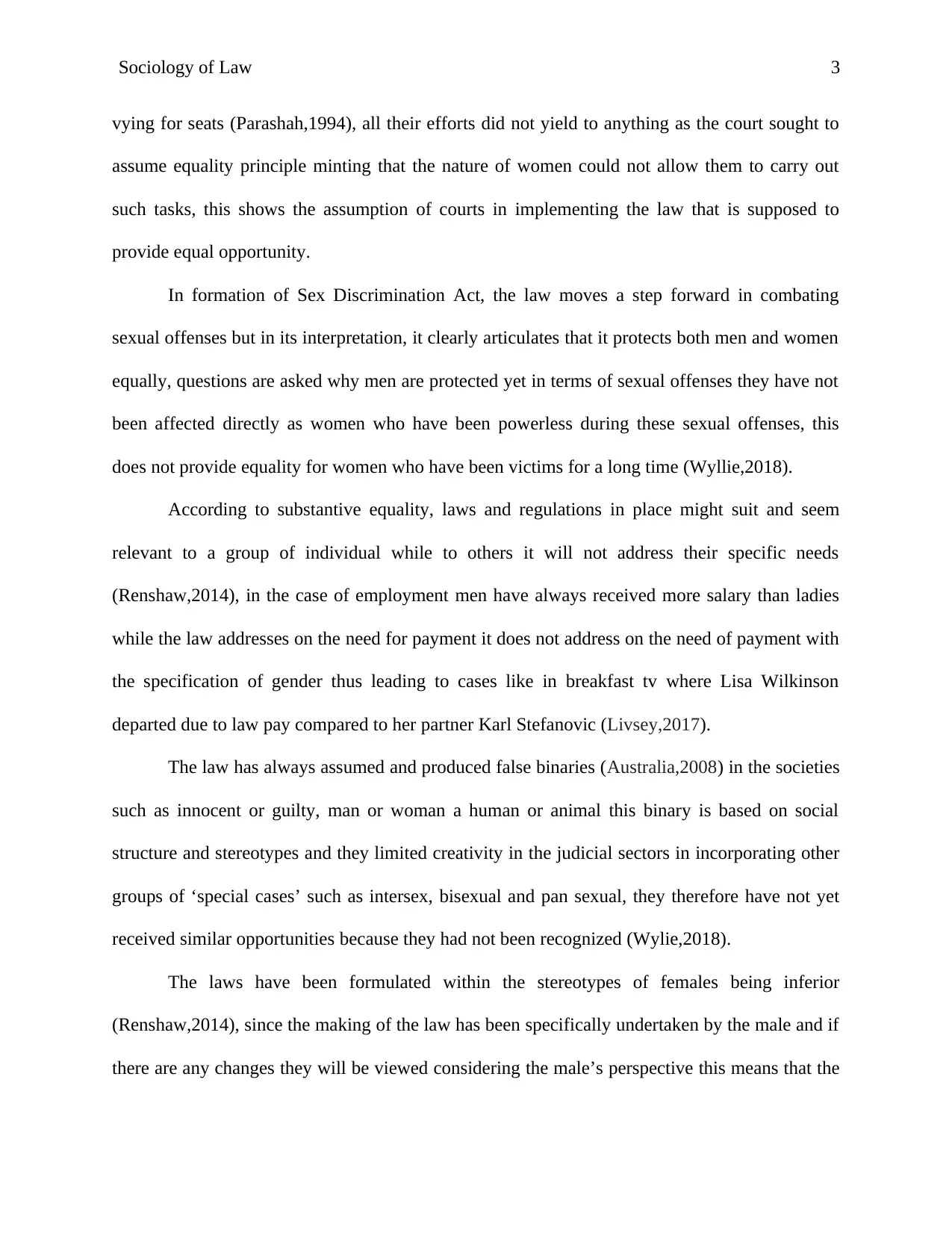
Sociology of Law 3
vying for seats (Parashah,1994), all their efforts did not yield to anything as the court sought to
assume equality principle minting that the nature of women could not allow them to carry out
such tasks, this shows the assumption of courts in implementing the law that is supposed to
provide equal opportunity.
In formation of Sex Discrimination Act, the law moves a step forward in combating
sexual offenses but in its interpretation, it clearly articulates that it protects both men and women
equally, questions are asked why men are protected yet in terms of sexual offenses they have not
been affected directly as women who have been powerless during these sexual offenses, this
does not provide equality for women who have been victims for a long time (Wyllie,2018).
According to substantive equality, laws and regulations in place might suit and seem
relevant to a group of individual while to others it will not address their specific needs
(Renshaw,2014), in the case of employment men have always received more salary than ladies
while the law addresses on the need for payment it does not address on the need of payment with
the specification of gender thus leading to cases like in breakfast tv where Lisa Wilkinson
departed due to law pay compared to her partner Karl Stefanovic (Livsey,2017).
The law has always assumed and produced false binaries (Australia,2008) in the societies
such as innocent or guilty, man or woman a human or animal this binary is based on social
structure and stereotypes and they limited creativity in the judicial sectors in incorporating other
groups of ‘special cases’ such as intersex, bisexual and pan sexual, they therefore have not yet
received similar opportunities because they had not been recognized (Wylie,2018).
The laws have been formulated within the stereotypes of females being inferior
(Renshaw,2014), since the making of the law has been specifically undertaken by the male and if
there are any changes they will be viewed considering the male’s perspective this means that the
vying for seats (Parashah,1994), all their efforts did not yield to anything as the court sought to
assume equality principle minting that the nature of women could not allow them to carry out
such tasks, this shows the assumption of courts in implementing the law that is supposed to
provide equal opportunity.
In formation of Sex Discrimination Act, the law moves a step forward in combating
sexual offenses but in its interpretation, it clearly articulates that it protects both men and women
equally, questions are asked why men are protected yet in terms of sexual offenses they have not
been affected directly as women who have been powerless during these sexual offenses, this
does not provide equality for women who have been victims for a long time (Wyllie,2018).
According to substantive equality, laws and regulations in place might suit and seem
relevant to a group of individual while to others it will not address their specific needs
(Renshaw,2014), in the case of employment men have always received more salary than ladies
while the law addresses on the need for payment it does not address on the need of payment with
the specification of gender thus leading to cases like in breakfast tv where Lisa Wilkinson
departed due to law pay compared to her partner Karl Stefanovic (Livsey,2017).
The law has always assumed and produced false binaries (Australia,2008) in the societies
such as innocent or guilty, man or woman a human or animal this binary is based on social
structure and stereotypes and they limited creativity in the judicial sectors in incorporating other
groups of ‘special cases’ such as intersex, bisexual and pan sexual, they therefore have not yet
received similar opportunities because they had not been recognized (Wylie,2018).
The laws have been formulated within the stereotypes of females being inferior
(Renshaw,2014), since the making of the law has been specifically undertaken by the male and if
there are any changes they will be viewed considering the male’s perspective this means that the
⊘ This is a preview!⊘
Do you want full access?
Subscribe today to unlock all pages.

Trusted by 1+ million students worldwide
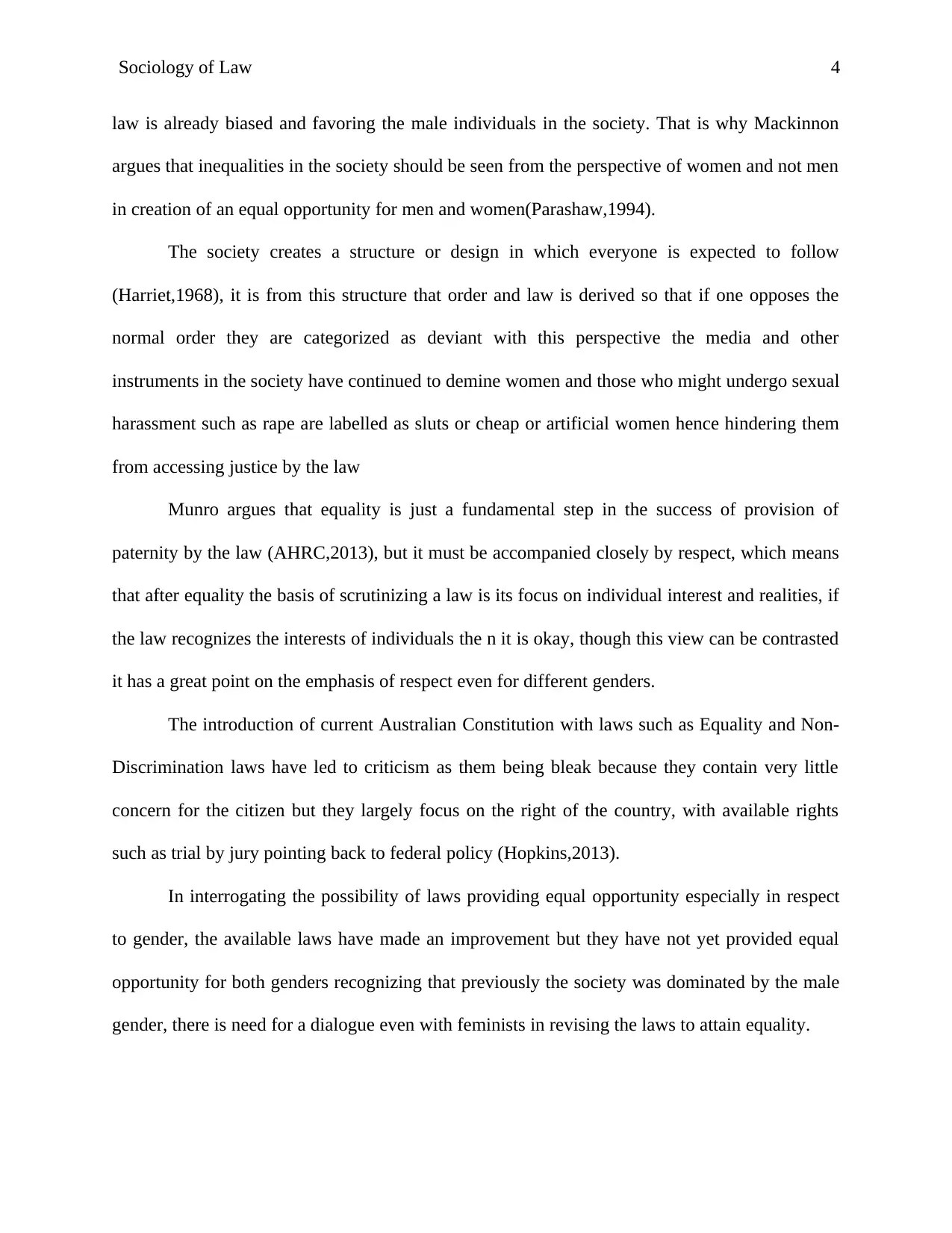
Sociology of Law 4
law is already biased and favoring the male individuals in the society. That is why Mackinnon
argues that inequalities in the society should be seen from the perspective of women and not men
in creation of an equal opportunity for men and women(Parashaw,1994).
The society creates a structure or design in which everyone is expected to follow
(Harriet,1968), it is from this structure that order and law is derived so that if one opposes the
normal order they are categorized as deviant with this perspective the media and other
instruments in the society have continued to demine women and those who might undergo sexual
harassment such as rape are labelled as sluts or cheap or artificial women hence hindering them
from accessing justice by the law
Munro argues that equality is just a fundamental step in the success of provision of
paternity by the law (AHRC,2013), but it must be accompanied closely by respect, which means
that after equality the basis of scrutinizing a law is its focus on individual interest and realities, if
the law recognizes the interests of individuals the n it is okay, though this view can be contrasted
it has a great point on the emphasis of respect even for different genders.
The introduction of current Australian Constitution with laws such as Equality and Non-
Discrimination laws have led to criticism as them being bleak because they contain very little
concern for the citizen but they largely focus on the right of the country, with available rights
such as trial by jury pointing back to federal policy (Hopkins,2013).
In interrogating the possibility of laws providing equal opportunity especially in respect
to gender, the available laws have made an improvement but they have not yet provided equal
opportunity for both genders recognizing that previously the society was dominated by the male
gender, there is need for a dialogue even with feminists in revising the laws to attain equality.
law is already biased and favoring the male individuals in the society. That is why Mackinnon
argues that inequalities in the society should be seen from the perspective of women and not men
in creation of an equal opportunity for men and women(Parashaw,1994).
The society creates a structure or design in which everyone is expected to follow
(Harriet,1968), it is from this structure that order and law is derived so that if one opposes the
normal order they are categorized as deviant with this perspective the media and other
instruments in the society have continued to demine women and those who might undergo sexual
harassment such as rape are labelled as sluts or cheap or artificial women hence hindering them
from accessing justice by the law
Munro argues that equality is just a fundamental step in the success of provision of
paternity by the law (AHRC,2013), but it must be accompanied closely by respect, which means
that after equality the basis of scrutinizing a law is its focus on individual interest and realities, if
the law recognizes the interests of individuals the n it is okay, though this view can be contrasted
it has a great point on the emphasis of respect even for different genders.
The introduction of current Australian Constitution with laws such as Equality and Non-
Discrimination laws have led to criticism as them being bleak because they contain very little
concern for the citizen but they largely focus on the right of the country, with available rights
such as trial by jury pointing back to federal policy (Hopkins,2013).
In interrogating the possibility of laws providing equal opportunity especially in respect
to gender, the available laws have made an improvement but they have not yet provided equal
opportunity for both genders recognizing that previously the society was dominated by the male
gender, there is need for a dialogue even with feminists in revising the laws to attain equality.
Paraphrase This Document
Need a fresh take? Get an instant paraphrase of this document with our AI Paraphraser
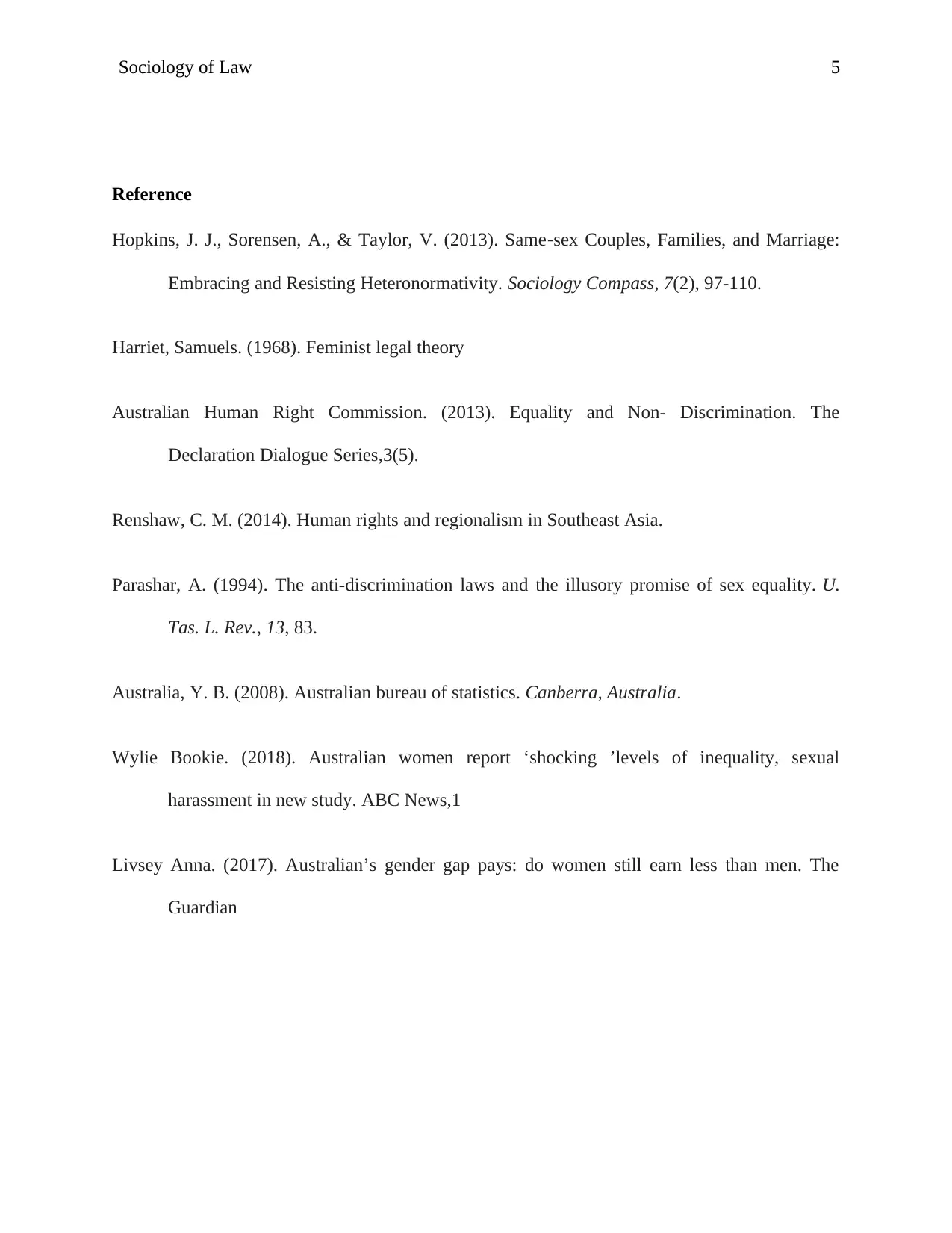
Sociology of Law 5
Reference
Hopkins, J. J., Sorensen, A., & Taylor, V. (2013). Same‐sex Couples, Families, and Marriage:
Embracing and Resisting Heteronormativity. Sociology Compass, 7(2), 97-110.
Harriet, Samuels. (1968). Feminist legal theory
Australian Human Right Commission. (2013). Equality and Non- Discrimination. The
Declaration Dialogue Series,3(5).
Renshaw, C. M. (2014). Human rights and regionalism in Southeast Asia.
Parashar, A. (1994). The anti-discrimination laws and the illusory promise of sex equality. U.
Tas. L. Rev., 13, 83.
Australia, Y. B. (2008). Australian bureau of statistics. Canberra, Australia.
Wylie Bookie. (2018). Australian women report ‘shocking ’levels of inequality, sexual
harassment in new study. ABC News,1
Livsey Anna. (2017). Australian’s gender gap pays: do women still earn less than men. The
Guardian
Reference
Hopkins, J. J., Sorensen, A., & Taylor, V. (2013). Same‐sex Couples, Families, and Marriage:
Embracing and Resisting Heteronormativity. Sociology Compass, 7(2), 97-110.
Harriet, Samuels. (1968). Feminist legal theory
Australian Human Right Commission. (2013). Equality and Non- Discrimination. The
Declaration Dialogue Series,3(5).
Renshaw, C. M. (2014). Human rights and regionalism in Southeast Asia.
Parashar, A. (1994). The anti-discrimination laws and the illusory promise of sex equality. U.
Tas. L. Rev., 13, 83.
Australia, Y. B. (2008). Australian bureau of statistics. Canberra, Australia.
Wylie Bookie. (2018). Australian women report ‘shocking ’levels of inequality, sexual
harassment in new study. ABC News,1
Livsey Anna. (2017). Australian’s gender gap pays: do women still earn less than men. The
Guardian
1 out of 5
Related Documents
Your All-in-One AI-Powered Toolkit for Academic Success.
+13062052269
info@desklib.com
Available 24*7 on WhatsApp / Email
![[object Object]](/_next/static/media/star-bottom.7253800d.svg)
Unlock your academic potential
Copyright © 2020–2025 A2Z Services. All Rights Reserved. Developed and managed by ZUCOL.





